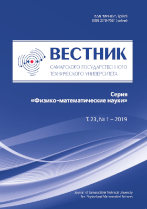|
Mathematical Modeling, Numerical Methods and Software Complexes
Gravitational field of a homogeneous cube. Classical and relativistic case
V. N. Makarova, L. A. Shleigerb, A.A Karasevcd
a Orenburg State University, Orenburg, 460018, Russian Federation
b Ioffe Physical-Technical Institute, Russian Academy of Sciences,
St. Petersburg, 194021, Russian Federation
c Institute of Industrial Ecology, Ural Branch of RAS,
Ekaterinburg, 620108, Russian Federation
d Ural Federal University named after the First President of Russia B.N. Yeltsin,
Ekaterinburg, 620002, Russian Federation
(published under the terms of the Creative Commons Attribution 4.0 International License)
Abstract:
The problem of studying the gravitational field of cube-shaped bodies is of great interest to geophysics, astrophysics, mathematical physics, and other fields. The first part of the article presents a brief literary overview of various methods for calculating the gravitational field potential of a homogeneous cube within the framework of classical mechanics: obtaining an analytical solution; as a special case of the problem of finding the gravitational field of a
polyhedron; by the finite element method; multipole decomposition. The method of calculating the gravitational field potential of a homogeneous cube using an analytical solution and multipole decomposition is analyzed in more detail. The second part of the article describes the relativistic case of the gravitational field of a homogeneous cube within the framework of post-Newtonian formalism in the first and second approximations. To solve the problem, a physical model was chosen that involved a balanced coordinate cube filled with an incompressible liquid with zero velocity and constant density. Relativistic corrections for the time and spatial coordinates are obtained. A precise analytical expression for these corrections in the region outside the cube, together with the components of the metric tensor, are obtained. A brief comparison of the results obtained for the relativistic case with the results of the classical Newtonian case is provided. The solution is obtained using numerical methods for the region inside the cube. The results obtained determine, with sufficient accuracy, the gravitational field parameters for a homogeneous cube considered in the framework of the relativistic approach.
Keywords:
homogeneous cube, gravitational field, gravitational field potential,
Newtonian mechanics, Post-Newtonian approximation
Received: February 26, 2024
Revised: March 12, 2024
Accepted: April 26, 2024
First online: September 13, 2024
Citation:
V. N. Makarov, L. A. Shleiger, A.A Karasev, “Gravitational field of a homogeneous cube. Classical and relativistic case”, Vestn. Samar. Gos. Tekhn. Univ., Ser. Fiz.-Mat. Nauki [J. Samara State Tech. Univ., Ser. Phys. Math. Sci.], 28:2 (2024), 302–323
Linking options:
https://www.mathnet.ru/eng/vsgtu2085 https://www.mathnet.ru/eng/vsgtu/v228/i2/p302
|

|



 Contact us:
Contact us: Terms of Use
Terms of Use
 Registration to the website
Registration to the website Logotypes
Logotypes